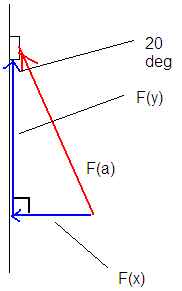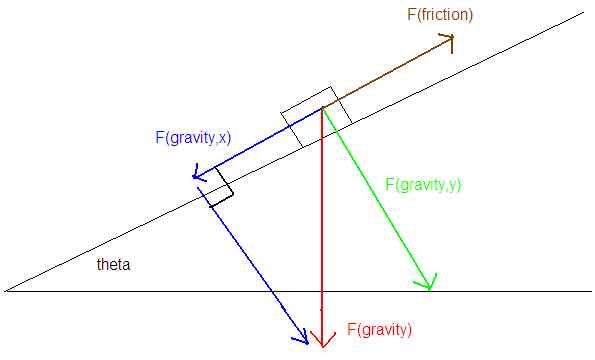

big314mp
Senior Members-
Posts
573 -
Joined
-
Last visited
Content Type
Profiles
Forums
Events
Everything posted by big314mp
-
sin(70) = F(x)/F(a), or F(a)*sin(70) = F(x) Remember that sine is opposite over hypotenuse. Replace your .94 with F(a)*sin(70), and you will get: F(y) = F(a)*sin(70)*.253 + .8*9.8 Now you have an equation with two variables, and you need it to be in one variable. BTW, the 9.8 comes from converting kg to newtons, as the kg is not a unit of weight, it is a unit of mass. So you need to find a relation between F(y) and F(a): cos(70) = F(y)/F(a), or F(a)*cos(70) = F(y) Substitute this in for F(y), and you will have an equation in one variable, which can then be solved using algebra. While you can do this problem using sine and cosine, on a test you may want to try the tangent function, as it can often get you to your answer in a more straightforward route. If you decide to do that, make sure you practice it.
-
Don't forget the coefficient of kinetic friction. You need to take that into account. Just calculate the force perpendicular (the normal force) using your trig, multiply by the coefficient of kinetic friction, and subtract from the force parallel. Then use that final force value for your last calculation. Other than that, excellent work!
-
No, it isn't the same. Where I have 20 deg, it should be 70 deg. Everything else should be the same.
-
F(y) = weight of sponge + Frictional force F(f) = u*F(x) Now you need a trig function that will relate F(y) to F(x) using the angle given in the problem.
-
No. Normal force is the force perpendicular to the plane. It is the green line (or the unlabeled blue, same thing) in the picture I posted. Mass times gravity is the red line. I'll list the relevant equations we have come up with, before I go to dinner: F(f) = u*F(n) F(f) = F(x) tan(theta) = F(x)/F(n) Rearrange those, and you should figure out theta. You don't actually need to find F(x), F(f), or F(n).
-
F(x) = F(static friction) So substitute this into the expression you had before (the tan(theta) one).
-
F(x) is equal to what at the moment when the box begins to move?
-
Irrelevant. You asked about work. I answered about work.
-
And earlier you argued that gravity was a repulsive force. http://www.scienceforums.net/forum/showthread.php?p=437617#post437617
-
I defy you to actually quote me saying that. There are straightforward equations that define when work is done. Work= Force x Displacement. I push a box across the ground for 100m, and I've done work. I lift a box up a flight of stairs I've done work. I push on a box, and it doesnt go anywhere, no work is done. A box flies through space, with no force pushing it, and no work is done. Electrons work the same way as the last scenario.
-
This is correct. That DOES NOT mean that a system can never produce work, and therefore power.
-
That sounds really cool. I'll try that sometime!
-
I'm just finding an excuse to avoid doing my calc homework
-
You do use trig to get the normal force, but you will be best off using the tangent function. I'm going to define the force perpendicular to the window as F(x) and the force parallel to the window as F(y). I'll define the applied force as F(a). Thus, F(x) and F(y) are the vector components of F(a). F(x) will be the normal force used to calculate friction. F(y) is the force that moves the sponge up the window (against gravity, and against friction). F(a) does not equal F(x), but you need to know either F(x) or F(y) to calculate F(a), using the sine or cosine function.
-
They don't, otherwise chemical bonds would cease to exist. I exist, therefore your theory fails.
-
They don't. Your theory still fails.
-
You should know that it is change in distance. Since the distance doesn't change, no work is done, regardless of the force.
-
You say electrons spiral into the atomic nucleus. They don't. Your theory fails.
-
The unlabeled blue line is just the green line shifted over, to make it easier to see the right triangle. Think about what u equals, and then think about what tan(theta) equals, in terms of the forces given in the picture. The angle between the unlabeled blue line, and the red F(gravity) line is also theta, btw.
-
-
So you are using some silly idea that you cooked up to contest reality? And, actually, we are talking about atoms and electrons.
-
Closer... F(vertical) = F(frictional) + weight of sponge Now you need to figure out how to get F(f). You also need a way to relate F(y) to F(x). You're doing great!
-
mooeypoo showed, both mathematically, and with a concrete example, as to how acceleration can be treated as a vector. The observations show that the electron doesn't do any work. So what exactly are you disputing here?
-
We are getting closer F(f) = u*F(n) is an equation that you will have to use. Remember that the sponge is moving upwards at constant speed. This means that the window washer is lifting the sponge, and so must apply enough force to lift the weight of the sponge. He must also overcome the frictional force. Since this problem is on a vertical surface, the normal force is not going to be the weight of the object. The normal force will come from the window washer. The window washer is pushing at a 20 deg angle. This means that his force is being applied to the sponge at a 20 deg angle. To find the forces you need, you must break this force into components. One component will be perpendicular to the window. This is your normal force (see the examples I posted earlier). The force going parallel to the window must overcome (think about what you can set this force equal to) the frictional force and the weight of the sponge.
-
Obviously not, as that would imply infinite power.


